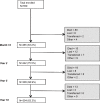Outcomes in a Cohort of Patients Started on Antiretroviral Treatment and Followed up for a Decade in an Urban Clinic in Uganda
- PMID: 26642214
- PMCID: PMC4671641
- DOI: 10.1371/journal.pone.0142722
Outcomes in a Cohort of Patients Started on Antiretroviral Treatment and Followed up for a Decade in an Urban Clinic in Uganda
Abstract
Background: Short-medium term studies from sub-Saharan Africa show that, despite high early mortality, substantial loss to program, and high rates toxicity, patients on antiretroviral treatment have achieved outcomes comparable to those in developed settings. However, these studies were unable to account for long term outcomes of patients as they stayed longer on treatment.
Objectives: We aim to describe ten years outcomes of one of the first cohort of HIV positive patients started on antiretroviral treatment (ART) in Sub-Saharan Africa.
Methods: We report 10-years outcomes including mortality, retention, CD4-count response, virological outcomes, ART regimens change from a prospective cohort of 559 patients initiating ART and followed up for 10 years Uganda.
Results: Of 559 patients, 69.1% were female, median age (IQR) was 38 (33-44) years, median CD4-count (IQR) 98 (21-163) cell/μL; 74% were started on stavudine, lamivudine and nevirapine, 26% on zidovudine, lamivudine and efavirenz. After 10 years 361 (65%) patients were still in the study; 127 (22.7%) had died; 30 (5%) were lost to follow-up; 27 (5%) transferred; 18 (3%) withdrew consent. The probability of death was high in the first year (0.15, 95%, CI 0.12-0.18). The median CD4 count increased from 98 to 589 cell/μL (IQR: 450-739 cell/μL) with a median increase of 357 cells/μL (IQR: 128-600 cells/μL); 7.4% never attained initial viral suppression and of those who did 31.7% experienced viral failure. Three hundred and two patients had at least one drug substitution while on first line after a median of 40 months; 66 (11.9%) of the patients were switched to a second line PI-based regimen due to confirmed treatment failure.
Conclusions: Despite the high rate of early mortality due to advanced disease at presentation the outcomes from this cohort are encouraging, particularly the remarkable and incremental immune-recovery and a satisfactory rate of virologic suppression.
Conflict of interest statement
Figures




Similar articles
-
Evaluation of treatment outcomes for patients on first-line regimens in US President's Emergency Plan for AIDS Relief (PEPFAR) clinics in Uganda: predictors of virological and immunological response from RV288 analyses.HIV Med. 2015 Feb;16(2):95-104. doi: 10.1111/hiv.12177. Epub 2014 Aug 15. HIV Med. 2015. PMID: 25124078 Clinical Trial.
-
Monitoring and switching of first-line antiretroviral therapy in adult treatment cohorts in sub-Saharan Africa: collaborative analysis.Lancet HIV. 2015 Jul;2(7):e271-8. doi: 10.1016/S2352-3018(15)00087-9. Epub 2015 Jun 16. Lancet HIV. 2015. PMID: 26423252 Free PMC article.
-
First-line antiretroviral therapy durability in a 10-year cohort of naïve adults started on treatment in Uganda.J Int AIDS Soc. 2016 Jun 17;19(1):20773. doi: 10.7448/IAS.19.1.20773. eCollection 2016. J Int AIDS Soc. 2016. PMID: 27319742 Free PMC article.
-
High rates of viral suppression in adults and children with high CD4+ counts using a streamlined ART delivery model in the SEARCH trial in rural Uganda and Kenya.J Int AIDS Soc. 2017 Jul 21;20(Suppl 4):21673. doi: 10.7448/IAS.20.5.21673. J Int AIDS Soc. 2017. PMID: 28770596 Free PMC article. Clinical Trial.
-
Prevalence, progression, and management of advanced chronic kidney disease in a cohort of people living with HIV.HIV Med. 2022 Nov;23(10):1078-1084. doi: 10.1111/hiv.13317. Epub 2022 Apr 26. HIV Med. 2022. PMID: 35470944 Review.
Cited by
-
Trends in one-year cumulative incidence of death between 2005 and 2013 among patients initiating antiretroviral therapy in Uganda.Int J STD AIDS. 2017 Jul;28(8):800-807. doi: 10.1177/0956462416671431. Epub 2016 Sep 20. Int J STD AIDS. 2017. PMID: 27651351 Free PMC article.
-
Adherence monitoring methods to measure virological failure in people living with HIV on long-term antiretroviral therapy in Uganda.PLOS Glob Public Health. 2022 Dec 30;2(12):e0000569. doi: 10.1371/journal.pgph.0000569. eCollection 2022. PLOS Glob Public Health. 2022. PMID: 36962730 Free PMC article.
-
Long-term clinical, immunological and virological outcomes of patients on antiretroviral therapy in southern Myanmar.PLoS One. 2018 Feb 8;13(2):e0191695. doi: 10.1371/journal.pone.0191695. eCollection 2018. PLoS One. 2018. PMID: 29420652 Free PMC article.
-
Longitudinal patients' cohorts for impactful research and HIV care at the Infectious Diseases Institute.Afr Health Sci. 2022 Aug;22(Spec Issue):11-21. doi: 10.4314/ahs.v22i2.4S. Afr Health Sci. 2022. PMID: 36321114 Free PMC article.
-
Long-Term Outcomes on Antiretroviral Therapy in a Large Scale-Up Program in Nigeria.PLoS One. 2016 Oct 20;11(10):e0164030. doi: 10.1371/journal.pone.0164030. eCollection 2016. PLoS One. 2016. PMID: 27764094 Free PMC article.
References
-
- UNAIDS Access to antoretrovira treatment in Africa. Status report on progress towards the 2015 targets. 2013. Availble: http://wwwunaidsorg/sites/default/files/media_asset/20131219_AccessARTAf....
-
- World Health Organization HIV/AIDS. Antiretroviral therapy coverage in sub-Saharan Africa. Available: http://www.who.int/hiv/data/art_coverage/en/. Accessed May 2014.
-
- Center for Disease Control and Prevention. Glocal HIV AIDS/Uganda. Available: http://wwwcdcgov/globalaids/Global-HIV-AIDS-at-CDC/countries/Uganda/.
Publication types
MeSH terms
Substances
LinkOut - more resources
Full Text Sources
Other Literature Sources
Medical
Research Materials
Miscellaneous

